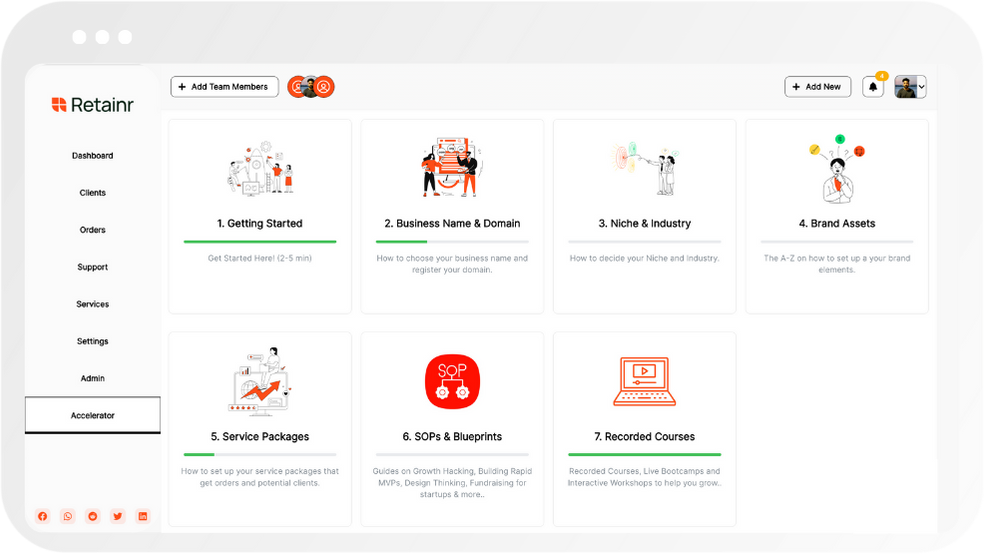
7 Ways to Improve Your Chatbot Accuracy
Build with Retainr
Sell your products and services, manage clients, orders, payments, automate your client onboarding and management with your own branded web application.
Get Started1. What are the seven ways to improve my chatbot's accuracy?
1. Improve Your Training Data
To improve Chatbot accuracy, you should consider enriching your training data. It's crucial to make it more diverse and representative of actual user interactions. You can consider using historical chat logs and FAQs. This data should cover different variations of user inquiries and must explicitly guide the bot on the responses it should make.
Here are some steps for improving your training data:
- Continuous data collection: Gather as much data as possible through user interactions.
- Regular data updates: Regularly update the training data with new sessions to let the bot adapt to evolving language patterns and user inquiries
- Check inconsistency: Identify and clear any inconsistent data that may confuse the bot
- Perform user simulation: Simulate a variety of user scenarios to prepare the bot for a wide array of situations.
2. Use Context-Awareness
Context-awareness is an essential aspect of human conversation. It refers to having a memory of past interactions. Implementing this into your chatbot can make it more intelligent and accurate. It allows the bot to consider the context of the conversation and come up with relevant responses.
Here are the steps for utilizing context-awareness:
- Construct a Memory Network: This mechanism lets the chatbot remember the context of the conversation. The bot can access this network for every user interaction.
- Implement Context-Aware Ranking: This allows the bot to rank responses depending on their relevance to the user's last query and the overall conversation context.
3. Conduct Regular Testing
The performance of your chatbot should regularly be evaluated by testing it under different scenarios. This helps you understand its strengths, weaknesses and areas for improvement. There are several methods to conduct these tests.
| Method | Description |
|---|---|
| Unit Testing | This checks each individual part of the bot's functions. It verifies that every small component of the bot operates as expected. |
| Integration Testing | This confirms that all components of the bot work well together. It tests how integrated parts of the bot interact with each other. |
| System Testing | This evaluates the bot as a whole system. It ensures that all the components of the bot work in harmony to offer a seamless user experience. |
2. Can the accuracy of a chatbot be improved with natural language processing?
Natural Language Processing and Chatbot Accuracy
The accuracy of a chatbot can indeed be significantly enhanced through the application of natural language processing (NLP). NLP is an AI mechanism that aims to understand, interpret, and generate human language in a value adding way. It assists chatbots to recognize and understand the complexities of human language such as context, sentiment, and intent. Through advanced NLP, chatbots can become more accurate and deliver better responses.
Here are some ways NLP can improve chatbot accuracy:
- Contextual Understanding : NLP helps chatbots understand the context of a conversation. This ensures that chatbots don't just respond to specific keywords but understand the overall message before giving a response.
- Semantic Interpretation : Through NLP, chatbots can understand the exact meaning in a sentence. For instance, interpreting whether a sentence is an instruction, a question, or a statement.
- Sentiment Analysis : NLP can enable chatbots to gasp the user's sentiment. Whether the user is happy, angry, or upset, the chatbot can adjust its responses accordingly.
- Multilingual Abilities : With NLP, chatbots can be programmed to understand and respond to multiple languages.
Accuracy Metrics For Assessing NLP in Chatbots
Several accuracy metrics can be used to assess the effectiveness of NLP in chatbots. These metrics also help in tweaking the chatbot for better performance.
| Metric | Description |
|---|---|
| Confusion Matrix | This is a table used to measure the performance of an AI model. It includes true positives, true negatives, false positives, and false negatives to give an overview of prediction accuracy. |
| Precision | Precision measures the number of correctly positive observations from the total predicted positives. |
| Recall | Also known as sensitivity, recall measures the number of correctly positive observations from the actual positives. |
| F1-Score | This is the harmonic mean of Precision and Recall. It gives a balanced representation of the two metrics. |
3. How does training my chatbot with more data increase its accuracy?
Training Your Chatbot with More Data
A chatbot's accuracy hinges greatly on its understanding of human language, responses and contexts. As the chatbot is a machine learning model, it depends on data to learn and improve. Therefore, the more data you have for training, the more information your chatbot can have to learn from. It would be able to handle a bigger variety of scenarios and respond accurately. Therefore, it's integral to frequently update your chatbot's training data set to enhance its accuracy.
Benefits of More Data
Training your chatbot with ample data offers several benefits including:
- Better Understanding: More data means your chatbot can learn from a wide range of contexts, improving its understanding of human conversation.
- Improved Accuracy: With a better understanding, your chatbot increases its prediction accuracy in terms of responses.
- Enhanced Adaptability: If exposed to various scenarios during training, your chatbot would be able to handle real-life situations more efficiently.
Amount of Data Vs Accuracy
The correlation between the volume of training data and chatbot accuracy can be represented in the table below:
| Amount of Training Data | Chatbot Accuracy |
|---|---|
| Low | Lower accuracy and understanding |
| Moderate | Improved understanding and accuracy |
| High | Best understanding and highest accuracy |
4. What is the role of regular updates in improving chatbot accuracy?
Importance of Regular Updates in Improving Chatbot Accuracy
Consistently updating a chatbot massively contributes to enhancing chatbot accuracy. Regular updates incorporate revised information that empowers a chatbot to perform its tasks more efficiently. They provide essential modifications and improvements, keeping the bot aware of the latest trends, business practices, user preferences, and technological advancements. Through updates, a Chatbot can also fix the identified weak points and malfunctions, thereby improving its accuracy.
A list of the main ways that regular updates improve chatbot accuracy:
- Fine-tuning the algorithms: The continuous refinement and tweaking of the bot's algorithms permits them to execute tasks more accurately and quickly.
- Adapting to changes or trends: Updates allow the chatbots to keep track and adapt to new changes, trends, or even language use in the market.
- Enhancing data security: Current updates often come with advanced features for data protection, which makes the chatbot more reliable due to improved data accuracy.
- Fixing bugs: One of the primary purposes of updates is to fix bugs or small errors in the bot's functioning which could have been impairing its accuracy.
Stated in the table below are some types of updates that significantly work in favor of improving a chatbot's accuracy:
| Type of Update | Purpose |
|---|---|
| Algorithmic Update | These updates refine algorithms which make the bot smarter and more accurate over time. |
| Trends Update | Enables the chatbot to keep on top of the latest trends, ensuring it doesn't provide dated responses. |
| Security Update | Prevents data breaches, ensuring privacy and maintaining a high level of user trust. |
| Bug Fixes | Helps in fixing errors that limit the chatbot's functionalities, thereby improving its ability to operate effectively. |
5. How do contextual understanding and chit-chat capabilities affect chatbot accuracy?
Enhancing Chatbot Accuracy through Contextual Understanding
Understanding the context in which a conversation takes place is crucial for chatbot accuracy. This involves interpreting the human interactions within a particular environment or situation. Traditional chatbots often answer questions based on pre-set rules and scripts, which limit their responsiveness to dynamic and complex conversations. However, with contextual understanding, chatbots can form a deeper understanding of the user's intent and respond more accurately.
There are several ways to improve chatbot accuracy through contextual understanding:
- Multi-turn Conversations: Chatbots should be capable of managing multi-turn conversations which involve back-and-forth exchanges between the user and the bot.
- Memory: The chatbot should be able to remember the user’s previous responses for continuity and coherence.
- Understanding Ambiguity: Chatbots should decipher ambiguous statements by assessing the context of the conversation.
The Role of Chit-Chat Capabilities in Chatbot Accuracy
Chit-chat capabilities refer to the bot's ability to maintain light, informal conversation with users. This helps in capturing the nuances of human conversation, making the interaction more natural and user-friendly. Chit-chat capabilities are integral to improving chatbot accuracy as they help the bot understand the user's tone, expressions and idioms.
Increasing chatbot accuracy using chit-chat capabilities involves:
- Tone Analysis: Understanding the user's tone lets the chatbot adapt its responses to the user's mood.
- Expression Recognition: Chatbots should recognise expressions and slang for a more human-like interaction.
- Idiom Comprehension: To connect with users naturally, chatbots must understand and appropriately respond to idioms.
| Contextual Understanding | Chit-Chat Capabilities | |
|---|---|---|
| Key Components | Multi-turn conversations, Memory, Understanding Ambiguity | Tone Analysis, Expression Recognition, Idiom Comprehension |
6. How can I reduce the frequency of wrong responses and increase the chatbot's accuracy?
Step 1: Training Your Chatbot with Relevant Data
Improving the accuracy of your chatbot begins with the training process. This involves feeding your bot with relevant and diverse data. Data in this context implies the dialogue and responses the bot would be using. The better the data quality, the higher the accuracy.
- Always make sure your chatbot is trained with relevant industry dialogues, jargon, and terminologies eliminating any form of ambiguity.
- Keep updating the chatbot's knowledge base regularly with new phrases and expressions that your users commonly use.
Step 2: Implement Contextual Understanding
Contextual understanding enables the chatbot to use the context of past requests to understand present conversations better. For a chatbot to function accurately, it must be able to understand the context in which a sentence is spoken. This builds seamless interaction between the chatbot and the user.
| Without context | With context |
|---|---|
| User: "What's the weather like?" Chatbot: 'I'm sorry, I don't understand.' | User: "What's the weather like in New York?" Chatbot: 'The weather in New York is currently sunny with a high of 75.' |
Step 3: Regular Testing and Feedback
Regular testing is crucial in order to identify any inconsistencies in the performance and spot patterns where the chatbot is making incorrect predictions. It also helps to rectify unseen errors and continuously improve the chatbot's accuracy. Implementing a feedback system is also super helpful. Users can provide feedback on whether the bot’s responses were helpful or not, which will inform future improvements.
- Have users test the chatbot, take their suggestions and feedback seriously and make amendments accordingly.
- Consider using A/B testing. Send half of your users to version A of your bot and the other half to version B, and see which one performs better.
7. What is the importance of structured data in improving chatbot accuracy?
The Importance of Structured Data in Improving Chatbot Accuracy
Structured data plays a pivotal role in enhancing the accuracy of chatbots. It provides clear and specific information that enables chatbots to understand and respond accurately to user queries. Structured data is organised in a manner that machines can understand, such as numbers, dates, and groupings, which allows for quicker and more precise search results. This efficiency is essential for chatbots to provide quick, appropriate responses and thus enhance user satisfaction.
Additionally, structured data contributes to the learning ability of chatbots. Through encountering and understanding the repetitive patterns and common phrases, chatbots continually enhance their intelligence, refining their predictive analysis and therefore their accuracy. Here are some examples of how structured data can be valuable:
- It helps the chatbot to understand and process natural language more effectively, improving NLP (Natural Language Processing)
- It enables the chatbot to organize and analyze large amounts of data
- It allows the chatbot to learn and adapt from past interactions, improving AI (Artificial Intelligence) learning capacities
Moreover, structured data aids in generating in-depth insights into user behavior. Understanding the user behavior assists in further enhancing the effectiveness of chatbot engagements. Consider the table below, outlining how the accuracy of chatbots can be improved with big data analytics:
| User Behavior | Improvements |
|---|---|
| Common Phrases | Better anticipation of possible enquiries, leading to faster, more relevant responses |
| Time of Interaction | Optimization of chatbot's availability and responsiveness during peak hours |
| Length of Interactions | Refinements made to chatbot programming to accommodate various customer patience levels |
8. How can integrating with backend systems help in improving my chatbot's accuracy?
Integration with Backend Systems
Integrating your chatbot with your backend systems can drastically improve its accuracy and efficiency in various ways. This process enables your chatbot to access relevant data, endow more personalized responses, and generally deliver better service to the users, resulting in an improved accuracy rate.
Below are some noteworthy advantages:
- Data access: With backend integration, a chatbot can access real-time data. This signifies that it can render accurate responses based on the latest available data.
- Personalized responses: Backend systems often incorporate significant details about the user, which the chatbot can leverage to provide more personalized and accurate responses.
- Better service: Backend integration allows chatbots to perform advanced tasks such as arranging appointments, making purchases, or issuing refunds, therefore offering a more intuitive and engaging user experience.
Understanding more about how backend integration improves chatbot accuracy can be methodically represented on a table:
| Integration Feature | Contribution to Accuracy |
|---|---|
| Data Access | It provides the chatbot with the most up-to-date information, leading to more relevant and precise responses. |
| Personalized Responses | Using user information from the backend, chatbot responses can be tailored to the user, significantly increasing accuracy. |
| Better Service | By supporting transactions and decision-making, the chatbot becomes more useful, therefore improving perceived accuracy. |
9. Does the usage of regular testing methods help in improving chatbot accuracy?
Regular Testing for Chatbot Accuracy
Yes, the employment of regular testing methodologies immensely helps in enhancing the functionality of chatbot systems. Regular testing allows for continuous improvement by identifying areas of weakness in the chatbot system and making the necessary adjustments. This ultimately leads to improved overall accuracy in chatbot responses and actions. Proper assessment of your chatbot's performance against a clearly defined set of criteria is imperative.
Chatbot testing can be arranged in several ways:
- Unit Testing: This is the process of testing small parts (units) of the chatbot system separately. It helps identify specific errors in the script.
- Functional Testing: This testing type assesses the system's performance, its capacity to provide the right responses, and detect user intentions accurately.
- User Acceptance Testing (UAT): UAT involves using the chatbot in real-world scenarios to determine whether it meets the user's expectations and requirements. It offers insights into how effectively the chatbot can interpret and process various user inputs.
Effectiveness of Regular Testing
The truthfulness of regular testing methods in promoting chatbot accuracy can be traced by the improvements observed after each round of testing. To illustrate this, here is a tabulated overview showing how regular testing might improve a sample chatbot's accuracy by impacting different chatbot performance metrics over a period of time.
| Testing Round | Response Accuracy (%) | User Satisfaction (%) | Error Rate (%) |
|---|---|---|---|
| Initial | 50 | 40 | 20 |
| After 1st round of Testing | 70 | 60 | 10 |
| After 2nd round of Testing | 85 | 80 | 5 |
In essence, regular testing aids in refining the AI model and improving its conversational skills, leading to an upsurge in the chatbot's overall performance and accuracy. It's a necessary ongoing process of quality assurance and optimization for all chatbot systems.
10. How does multi-language support improve chatbot accuracy and usability?
Understanding Multi-Language Support in Chatbots
Accurate and helpful chatbots have become almost indispensable in today's fast-paced digital world. As businesses look to broaden their reach globally, the ability for a chatbot to interact accurately in multiple languages is a real asset. Multi-language support not only increases chatbot accuracy but also improves its usability.
Improving Chatbot Accuracy with Multi-Language Support
Modern chatbots employ Natural Language Processing (NLP) technology, which essentially enables them to understand, interpret, and respond to user queries appropriately. Supporting multiple languages improves their accuracy in several ways:
- The chatbot can cater to a more diverse range of customers.
- It assists in understanding regional nuances and slang, resulting in more accurate communication.
- Provides an opportunity for continual learning and growth of the chatbot's knowledge base as it interacts in various languages.
Enhancing Chatbot Usability through Multi-Language Support
Aside from accuracy, multi-language support also plays an integral role in enhancing chatbot usability. Let’s understand how:
| Aspect of Usability | Impact of Multi-Language Support |
|---|---|
| User Reach | Enables the chatbot to communicate with users globally, irrespective of the language barrier. |
| User Satisfaction | By catering to users in their preferred language, chatbots can offer more personalized and satisfactory experiences. |
| User Convenience | Eliminates the need for users to translate their requests or responses. |
In conclusion, multi-language support essentially increases the versatility and efficiency of chatbots, making them a valuable tool for businesses to engage with their diverse customer base.
Conclusion
Improve Chatbot Accuracy with Retainr.io
Enhancing chatbot accuracy is crucial for businesses to offer excellent customer service. High-quality chatbot interactions ensure prompt responses and a better understanding of customer needs. Here are seven methods to refine chatbot accuracy:
1. Constant Training of Your Chatbot
Routine training of your chatbot with new data and diverse scenarios empowers it with updated knowledge that leads to accurate responses.
2. Tailor Conversational Flow
Designing your chatbot to understand the flow of conversation rather than just keywords aids in precise communication.
3. Employing Multi-Turn Intent
Enhance chatbot accuracy by teaching it to take multiple turns in a conversation.
4. Implementing Contextual Understanding
Equip your chatbot with the ability to comprehend the context of the conversation, improving accuracy in its responses.
5. Applying Machine Learning
Machine learning can greatly improve chatbot accuracy over time.
6. Accurate Language Processing
High-quality language processing enhances chatbot communication and understanding, hence bettering accuracy.
7. Routine Testing and Improvement
Continual evaluation and enhancement of chatbot functionality is pivotal for maintaining and increasing its accuracy.
If you are looking to augment your chatbot accuracy, Retainr.io is the solution. As a whitelabel software, it allows you to sell, manage clients, orders, and payments with your own branded app.
Not only does it assist with chatbot improvement, but also streamlines your business operations and enhances customer interaction. Consider increasing your chatbot's accuracy and your business efficiency with Retainr.io today.
Boost Your Agency Growth
with Retainr Accelerator
Uncover secrets, strategies, and exclusive blueprints to take your agency's growth to the next level — from marketing insights to effective presentations and leveraging technology.

SOPs, Cheatsheets & Blueprints
Leverage 50+ SOPs (valued over $10K) offering practical guides, scripts, tools, hacks, templates, and cheat sheets to fast-track your startup's growth.
Connect with fellow entrepreneurs, share experiences, and get expert insights within our exclusive Facebook community.
.jpg)

Join a thriving community of growth hackers. Network, collaborate, and learn from like-minded entrepreneurs on a lifelong journey to success.

Gain expertise with recorded Courses, Live Bootcamps and interactive Workshops on topics like growth hacking, copywriting, no-code funnel building, performance marketing and more, taught by seasoned coaches & industry experts.

.jpg)

.jpeg)


